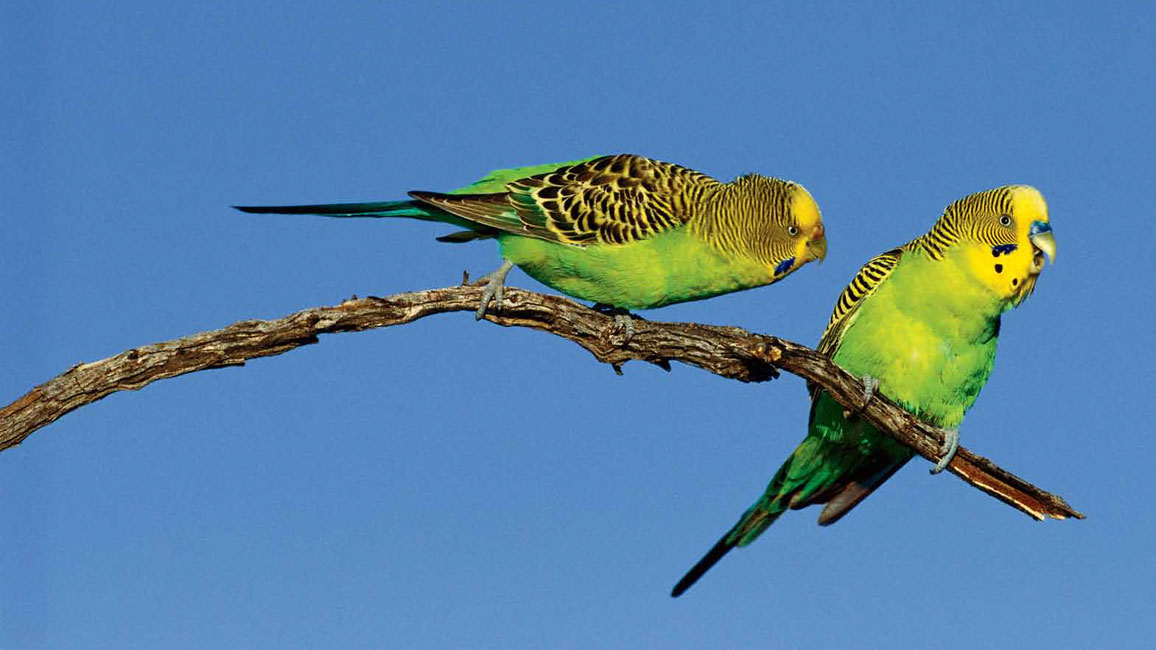
Budgies
By Ellen LambethDo these birds look like pet parakeets to you? Look again and discover their wild side!
Want to track down a flock of parakeets in the wild? Then head for Australia (see map). But don’t ask where the parakeets are. Ask where you can find budgies. That’s because a parakeet is any kind of small, slender parrot with a long tail. The kind you’d be looking for is called a budgerigar (BUHJ-uh-reegar), nicknamed “budgie.”
Once you get the name straight, you’ll be directed to the Outback — and we don’t mean the restaurant of that name. The real Outback is the open countryside across much of Australia. Not many people live there, but it’s home to wild budgies.
Do these birds look like pet parakeets to you? Look again and discover their wild side!
HOME ON THE RANGE
The Outback is usually hot and dry. But budgies have lived there for so long that they’ve worked out ways to deal with it. For example, they can go a long time without drinking, if they have to. Meanwhile, their bodies get water from the food they eat—mainly grass seeds. Another budgie survival trick is to lead a nomadic (noh-MAD-ik),
or wandering, life. When times are good, the birds gather in small flocks, flitting from here to there. When they’ve gobbled up all they can find in one spot, they move on to the next spot — and then the next.
Sometimes it becomes so dry, the grasses just wilt and wither away. Then the flocks join other flocks and roam far and wide in search of food and water. Some of these combined flocks have many thousands of birds and travel many hundreds of miles. Times can get really tough for budgies during a drought (DROWT). That’s an extra long period when it’s extra dry. Many of the birds die when they can’t find enough to eat. But others survive and keep searching. Eventually, their luck changes, and they find a place where the rains have come. Rain means the grasses grow again and make new seeds. And that means it’s also the perfect time to make new budgies!
BABY BOOM
Budgies get busy raising families after a good rain. They want to take advantage of a big food supply while it lasts. Each pair seeks out a hole in a hollow tree or log. Mom lays four to six eggs and keeps them warm for nearly three weeks. The chicks are helpless when they hatch, and they remain that way for the next three weeks. Up to his point, Dad’s only job is to bring food to Mom. But when the chicks start growing feathers, he’s allowed to go into the nest and help take care of them. That lets Mom take a break once in a while.
After another few weeks, the babies are ready to spread their wings and take off on their own. If there’s still plenty of food and water, Mom and Dad may start another family right away.
As you can tell, life is pretty much “boom or bust” for wild budgies. Good thing there are rainy “boom” periods to make up for the hard times when things seem to go “bust” in the dust.
BUDGIE BRUNCH?
A little ball of green, feathery fluff is a clue that the falcon below made a lucky strike. The predator most likely snatched
its budgie prey right out of the air with its sharp talons.
BABY BUDGIE BUNDLE
Budgie eggs are laid a couple of days apart, and they hatch in the same order. You can tell which chick above was the last one out of its shell. It doesn’t yet have a downy coat, and its eyes are still shut tight.
BEAK-TO-BEAK
While the female is busy tending eggs, her mate must deliver meals to her. Here, she greets him at the nest hole opening so he can feed her.
“Budgies” originally appeared in the April 2010 issue of Ranger Rick magazine.
(Click on each image above for a closer view of the story.)



















